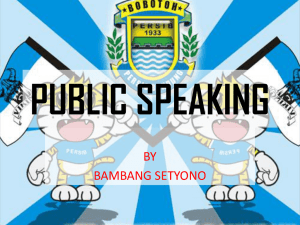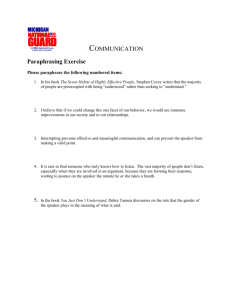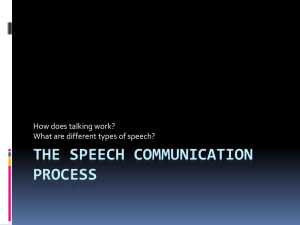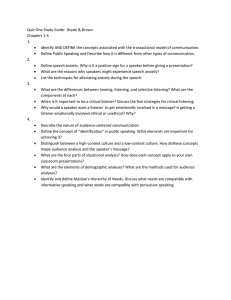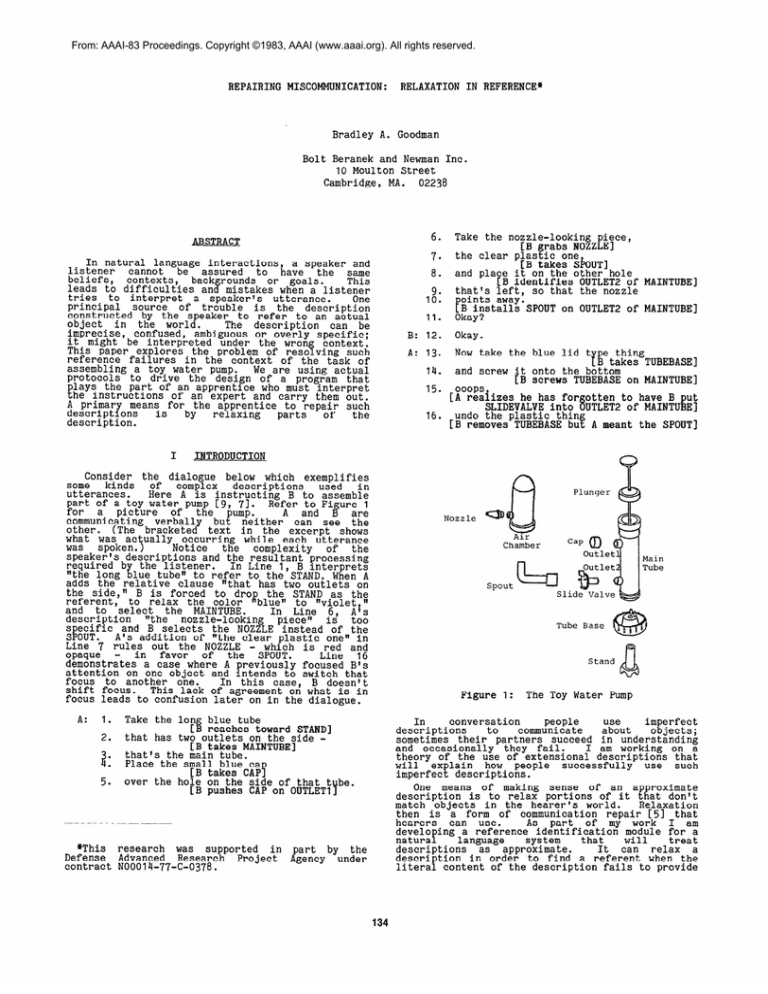
From: AAAI-83 Proceedings. Copyright ©1983, AAAI (www.aaai.org). All rights reserved.
REPAIRING MISCOMMUNICATION: RELAXATION IN REFERENCE*
Bradley A. Goodman
Bolt Beranek and Newman Inc.
10 Moulton Street
Cambridge, MA. 02238
ABSTRACT
In natural language interactions a speaker and
listener cannot be assured to have the same
beliefs, contexts, back rounds or goals.
'
leads to difficulties anLfmistakes when a list%:
tries to interpret a speaker's utterance.
One
principal source of trouble is the description
constructed by the speaker to refer to an actual
object in the world.
The description can be
imprecise, confused, ambiguous or overly specific;
it might be interpreted under the wrong context.
This paper explores the problem of resolving such
reference failures in the context of the task of
assembling a toy water pump. We are using actual
protocols to drive the design of a program that
lays the part of an apprentice who must interpret
ehe instructions of an expert and carry them out.
A primary means for the apprentice to repadifsuch
descriptions is
by
relaxing parts
the
description.
I
1.
2.
.
2.
5.
Take the nozzle-looking piece,
7.
the clear p!~s&!~b&!oZZLE1
[B takes SbOUT]
and place it on the other hole
CB identifies OUTLET2 of MAINTUBE]
that's left, so that the nozzle
oints away.
PB installs SPOUT on OUTLET2 of MAINTUBE]
Okay?
8.
18:
11.
B: 12.
Okay.
A: 13.
Now take the blue lid t pe thing
fB takes TUBEBASE]
and screw it onto the bottom
[B screws TUBEBASE on MAINTUBE]
14.
15.
16.
[~"~%izes he has forrtten to have B put
SLIDEVALVE into UTLET2 of MAINTUBE]
undo the plastic thin
CB removes TUBEBASE bu& A meant the SPOUT]
INTRODUCTION
Cons&lld; tFf dialogue below which exemplifies
.
some
descriptions
utterances. Here c~mf~e%structing B to "a"sesdembie"
pa;t of ",i"co,"uryte;fpump
C9, 71. Refer to Figure 1
a
the pump.
A and B are
communicating verbally but neither can
other. (The bracketed text in the excerp?eeshiiE
what was actually occurring while each utterance
was spoken.)
Notice the complexity of the
speaker's descriptions and tIh..
[;;zl;ant processing
required b the listener.
B interprets
"the long Elue tube,,to refer to the'STAND. When A
adds the relative clause "that has two outlets on
the side,,, B is forced to droff the STAND as the
referent, to relax the color blue,, to ,,violet,,
and to selec(FthJhe MAINTUBE.
In. Lir$a 6, A1s
description
nozzle-looking
too
specific and B selects the NOZZLE p&%eadl~f
the
SPOUT. A's addition of Iftheclear plastic one,,in
Line 7 rules o"ftav;;e
oNfoZZLE- which is Lyndear;:
the SPOUT
%%%~trate%"a
case where A previousl$ focused B's
attention on one object and intends to switch that
focus to another one.
In this case, B doesn't
shift focus. This lack of agreement on what is in
focus leads to confusion later on in the dialogue.
A:
6.
Take the long blue tube
CB reaches toward STAND]
that has two outlets on the side CB takes MAINTUBE]
that's the main tube.
Place the small blue ca
[B takes CAPP
over the hole on the side of that tube.
[B pushes CAP on OUTLET11
*This research was supported in part by the
Defense Advanced Research Project Agency under
contract NOOOl4-77-C-0378.
134
Plunger
Nozzle
Slide Valve
Tube Base
Stand
Figure 1:
The Toy Water Pump
the needed information.
In this paper I will
describe the relaxation component of the reference
identification module and illustrate some of the
sources of knowledge that guide it in relaxing a
description.
11
;;c);z;rtion itself and the Real World described
Therth;;e ;;T;;outhgources of knowledge
to consider
reference repair
process. We will look at two sources linguistic
;I$ percepyfal ;;eowledge. Ling;;;tic knowled:; is
use
structure
description. Perceptual knowledge %an,l"",erson:z
abilities to distinguish feature values
preferences in features by considering which'z:ez
more important (with respect to the person anttiE;
domain), and one's perception of an object.
knowledge
sources, - such
discourse
knowledge
, 14, 18, 17, 15, 2, llf'
knowledge El 1, 13, 31, trial and e&or k!Et!T
edatzc
*
hierarchical' knowledge, and domain knowledge I?
9
will not be covered here. A more detailed treatment
can be found in C83.
l
T&E KINDS OF PROBLEMS
Part of my research has been an examinatioonof
how a listener iil;;;ersan;ha\o; ;;pir
description is
discovers the source 'of the problem lis
in teK:
communication.
o How the problems are discovered:
Real0 World
1. The li.stecEr finds m
correspond
object
the
speaker's description;
2.
the listene;umyenrds
o;theR',aihanWo;;;
requested
ObJects (i.e., too many or too few);
the
3. the listener cannot
speaker
action s ecified by iEform
because oP some obstacle; or
4.
the listener perfora$ tr6?sactionbut
intended
zo,;dctnot arrive
.
o
A. Linguistic Knowledge in Reference
Different linguistic structures can be utilized
to describe objects in the extensional world. This
section outlines some of these structures and their
meanings and shows how they can be used to guide
repairs in the description.
A description of an object in the extensional
world usually includes enough information about
physical features of the object so that listeners
can use their perceptual abilities to identify the
object.
Those physical features are normally
specified as modifiers of:nouns and ronouns. The
typical modifiers are aad,JdectiveS,
re.ative
c!',;?;~:
P
adjective clauses)
pre ositional
Phey
phrases).
are
often
tadjective
interchangeable, that is, one could specify a
feature using any of the modifiers. One modifier,
however, may be better suited for expressing a
feature than another.
Relative clauses are well suited for expressing
complicated information since they are separate
from the main part of the noun phrase and can be
arbitrarily complex themselves.
Where the problems may reside:
1. In the speaker's description of an
object presented in the utterance;
2. in the speaker's description of a
physical action presented in the
utterance;
thEa;;t obLepal World objects
3. +&
into
brought
attention (the speaker's set may
differ from the listener's set);
4. with the set of Real World actions
been
brought
into
have
that
attention (the speaker's set may
differ from the listener's set);
interpretation of
the
the
5. in
yfd:rlying force of the utterance
doestothesigmPpelaykern~~.t
",;E
liAte;er
information in the utterance or to
use it to do something); or
the hearer's concentration
6. with
Assertions
of
,,extra" information,
information possibly outside the domain
tf;;;;~;e and not useful for findi,:agntte
f! at this time.
(e.g.,
shaped tube of clear plastic that &
defined as a snout,,).
Material useful for confirmin
proper referent was found.
$ that "KS
long blue tube that has two out?it%)on the
side,,).
respecification
the
initial
description in more de&l
For example,
in the case of the descriptions "the thing
that is flared at the tw" and "the main
tube whir&
the binnest tube," the
relative clauses are needed because the
initial descriptions are too vague.
These observations signal conditions in which a
mistake might occur and where it might be found.
We will now explore what a listener has available
for resolving miscommunication.
III
KNOWLEDGE FOR REPAIRING DESCRIPTIONS
When things go wrong during a conversation,
people have lots of knowledge that the
bear to get around the problem (see [161E "M'~% :I!
the time the repairs are so natural that ~;~a;;;;;
;;-II~~OUS that they have taken place.
we must make an effort to correct what we
have heard, or determine that we need clarification
from the speaker. This repair process involves the
use of knowledge about conversation, its social
conventions and the world around us.
In this work, I chose to consider the repairT;E
descriptions rather than complete utterances.
most relevant knowledge for repair depends on the
Prepositional phrases are better fitted for
simpler pieces of information. They are often used
to express predicative relationships.
superlative relation
' te.~o~p~~~,?~~all%t of the red pieces"),
o thesubpart specifi;ation - used to access
subpart
the
ObJect
under
consideration (e..g., "the top end fl the
little elbow pint, ,, "that water chamber
with the blue ottom and the globe top">,
o Most perceptual features (e.g., "with a
clear tint,,,"with a red color,).
Just like relative clauses, prepositional phrases
can also provide confirmation information.
Adjectives are used to express almost
erceptual feature - though complex relations %%
Ee awkward. Usually they modify the noun phrase
directly, but sometimes they are expressed as a
*I am including this kind of problem because I
have been talking about human dialogues. I will
not, however, pursue it any further.
135
predicate complement.
In those situations, the
cornlement describes the subject of the linkin
verg (eq., "the tube is large"). As with some oF
the rela ive clauses above predicate complements
have an assertional nature go them.
also be confusing because the speaker and listener
may have differing sets of values for a feature
(e.g., what
be blue for someone
be
turquoise formznother)
These characteF?$tics
affect the salience of a feature (see cl211 which
in turn determines the feature's usefulness in a
A feature that is common in everyday
shape and size) is salient
,licsotleonre)r
can readily distinguish the
feature's possible values from each other.
Of
course, very unusual values of a feature can stand
out, making it even easier to discriminate a unique
object from all other objects [12].
The objects in the world may exhibit a feature
whose possible values are difficult to distinguish.
This occurs when a perceived feature does not have
much variability in its range of values: all the
values are clustered close1 together making it
;;;d pex,"etl ?-~~~differenceJbetween one value and
increases the likelihood of
confusion because the usefulness of specifying the
feature to a non-expert is diminished (es ecially
if the speaker is more expert than the lis&ener in
distinguishing feature values). Hence, if one of
these difficult feature values appears in the
speaker's description, the listener, if he isn't an
expert, will often relax the feature value to any
of the members of the set of feature values.
B. Relaxi;aea DescriDtion Using Linguistic
Know
a
The relaxation
attempts to relax
features
in
d~~%$?ioion
the
ad'ectives, thenaprepositional pht&es and f$%%ii
rei!
ative clacUhsoesnand
predicate complements.
order was
by examining the water pump
protoco;l.tandp~~ynotlngwhere the linguistic forms
come
during reference resolution.
Adjectives and .prepositional phrases pla a more
central rol;o~~ile relative clauses.usualfy play a
secondary
referent identification
Relative clauses &%i$edicate
complements exhibit
an assertional nature that reduces their usefulness
for resolving the current referencte (w;t;fe;~ the
information they express can
subsequent references). The head noun can also i:
relaxed. It normally is relaxed last but could be
relaxed prior to a relative clause (especially in
the instances where the relative clause expresses
confirmational information).
For example, consider the description "the lar e
violet cylinder that has two outlets.,, Here, t8e
features size, color and sha e are described in the
adjectives and head noun oB the description, and
the two subparts, function in the relative clause.
Following the above rules, the relaxation of size,
color and shape should be attempted before either
the number of subparts or the subparts, functions.
The relaxation order is influenced by the other
knowled e sources so the order proposed here is not
hard an8 fast.
D. %&axiyea
w
a
DescriDtion Using PerceDtual
When examining the features presented in a
speaker's description, one can consider perceptual
aspects to determine which features are most likely
in error.
Such an inspection can generate a
partial ordering of features for use during the
repair procestsot;elde;ermin;swh;;!wnfe;~l~w inthg
description
relaxation ordering su ested by the inspection of
features interacts wiffl ordering proposals from
other knowledge sources.
Active features are ones that require a listener
to do more than simply recognize that a-particular
feat;;: value belongms&o ;e;efl;r;fpossibl;i;,dalues
listener
some
of
evaluation.
When considerin
the water
domain, it seems that one shoul5 first relax tREi,P
features that require less active consideration
such as color (thou h it is easier to relax red to
orange
than
ref
to
blue),
composition,
transparency, sha e and function. Only after this
should one relax tp
hose features that require active
consideration of the object under discussion and
its
surroundings
(such
as
sulpifi;(relatives,
comparatives, and relative values
size,
height, thickness, position, distance and
i2g,"j
People tend to be casual with less active
feature; whileHekpe active ones require their full
attention.
in a reference failure the
source of the problem is likely to be the less
active ones.
l
C. PerceDtual Knowledge in Reference
A major factor involved here is how people
perceive objects in the world and how this can be
simulated in m system. Each objectspfaqtriF
p "y;";y
is denoted t
two forms*
representation &d a cognitiv&litguistic form that
shows how the system could actually talk about the
object.
Theofspatt.$ description is a physical
description
its
dimensions, the basic 3%J%~pe~nco~l?~%sng 'ft and
its physical features.
The cognitive/lingu&tic
form is a representation of the parts and features
of the object in linguistic terms. It overlaps the
visual form in many respects but it is more
suggestive of the listener's perceptions.
The
cognitive/linguistic form describes asDects of an
object such a% its subparts by its position on the
object ("top", "bottom") and its functionality
(,,outlets,,"Places for attachment,,). More than
one cognitive/linguistic form can refer to the same
physical description. Some properties of an object
differ in how they are expressed in the two forms.
In the 3-D form there *are primarillr3
przgr;t$e;
such as ;;~ri;~~icdlmensions (e.g.,
feet,,)
shapes
(e.g,,
eneralized
cylinders), while, in the cognitive7 linguistic
form, there are relative dimensions (e.g., ))large,,)
and analogical shapes (e.g., "the L-shaped tube >.
Perception, hence, may involve interpretation.
This can lead to discrepancies between individuals.
People usually agree on the spatial representation
but not necessaril.y on the cognitive/linguistic
&J;;i$.ion and this can lead to problems.
For
mlsJudgements by the speaker in calling an
object trlarge,,
can cause the hearer to fail to find
an object in the visual world that has dimensions
that are perceptually "large" to the listener.
To prevent confusion of the listener, a speaker
must distin uish the objects in the environment
from each o% her.
The perceptual features of an
object provide people with a way to discriminate
one object from another. A speaker must take care
when selecting from these features since they can
induce their own confusion.
Perceptual features
ma
be inherently confusing because a feature's
vaIues are difficult to judge (e.g., is the tube a
cylinder or a slightly tapering cone?). They may
l
136
IV
THE RELAXATION COMPONENT
I have discussed some of the numerous kinds of
knowledge available to a listener to interpret a
s eaker s description. I pointed out places whe;:
&at knowledge affects the listener's abilit
interpret a description and ways in which 13 is
helpful to the listener for overcoming
descriptions. When a description fails to de%%:
properly a referent in the Real World, it is
possible to repair it by a relaxation process that
drops or modifies parts of the description. Since
a description can specify many features of an
object, the order in which parts of it are relaxed
is crucial. There are several kinds of relaxation
possible. One can ignore a constituent, replace it
with something close, replace it with a related
*For example certain Eskimo languages have names
for many different grades of snow that ma
difficult for most non-Eskimos to distinguish r19P
value, and change focus (i.e., consider a difIfe;zyi
In this section,
roup of objects.).
3escribe the overall relaxation cornonent that
draws on the knowledge sources as it tr!es to relax
the errorful description to one that suffices.
A. Find a Referent Using a Reference Mechanism
Identifying the referent of a description
entails finding an element in the world that
corresponds to the speaker's description (where
,,describedby,,means every feature specified in the
description is present in the element in the world
but not necessarily vice versa>. The initial task
of our reference mechanism is to determine whether
or not a search of the (taxonomic) knowledge base+
is necessary. A number of aspects of discourse
m-a atics can be used in that determination but I
wilY not examine them here.
If a search of the knowledge base is considered
necessary, then the reference search mechanism is
The search mechanism uses the KL-One
invoked.
Classifier [lo] to search** the knowledge base
taxonomy.
The Classifier uses the subsumption
relationships inherent in the taxonom to place the
descripFiyh i;estphe;tcorrect
spot Cl07 ! What this
to reference is that the
means
possible referents of the description will be found
below the description after it has been classified
into the knowledge base taxonomy. If more than one
referent is below the classified description, then,
unless a quantifier in the description specified
more than one element the speaker's description is
ambiguous. If one description is below it, then
the inteFnid,eadll&eferent
is assumed to have been
if no referetetn
istfhOeUnd
below the
found.
deicription,
relaxation
classified
component is invoked.
At this point the ref;rdnceth;ysteminspects t.;'$
candidates
speaker's description
decides which features to relax and in what order."
Once the feature order is created, it determines
the order in which to try relaxing the candidates.
Various knowledge sources are consulted to
determine the relaxation orderin . These include
the perceptual and linguistic a nowledge sources
that were described above, as well as others not
discussed here. The suggestions from the knowledge
This integration
sources are then integrated.
requires evaluating the partial orderings imposed
by each knowledge source. For example, perceptual
knowledge says to relax color.
However, if the
color value was asserted in a relative clause,
lin uistic knowledge would rank color lower. This
lea8s to a conflict. Thus the relaxation of some
other feature may win ouc over color should it
cause less conflict.
Thus the feature ordering can be used to order
candidates: choose first those candidates that best
follow the feature order when determining changes
that must be made to the speaker's description.
The control structure to enforce this rule examines
each candidate and assigns a higher priority to
those candidates that exhibit a feat;;iceranked
the
higher in the order of features.
candidates with the least important features,slip
to the back of'the queue.
Once a potential candidate is selected by the
controller, the relaxation mechanism begins step 3
of relaxation; it tries to find proper relaxation
u~?n;;l; to relax the *features*that have just been
methods
(success
finding
such
"justifies" relaxing tlhne
description).
It is necessary to determine whether or not the
lack of a referent for a description has to do with
the description itself - i.e., reference failure
- or outside forces that are causing reference
confusion.*+* Pragmatic rules are invoked to decide
whether or not the description should be relaxed.
These rules will not be discussed here.
C. Perform the Relaxation of the DescriDtion
If&el$xation
is voted for, then the system must
.
potential referent candidates, (2)
&;min;ndwhich
features to relax and in what
use that to order the potential
candidates with ar,edSPect
to the preferr;teordering
determine
features,
of
(3)
pro g
relaxation techniques to use and apply them to 1
description.
3. Determine which relaxation methods to apply
Relaxation can take place with many aspects of a
speaker's description: with the focus of attention
in the Real World where one attempts to find a
match, with complex relations specified in the
description, and with individual features of a
referent specified by the description.
Often the objects in focus in the Real World
implicitly cause other objects to be in focus
The subparts of an object in focus, for
[9, 181.
example, are reasonable candidates for the refere;;
of a bad description and should be checked.
other times, the speaker might attribute features
of a subpart of an object to the whole object
describing a plunger that is composed of a
i%'yandle
a metal rod, a blue cap, and a green
cases, the
cup as "th& green plunger"). In tthJese
part-whole
relaxation mechanism
follows
linguistic
knowledge
base
contains
*The
descriptions and a description of the listener's
Here it is represented in
visual scene itself.
KL-One [41, a system for describing inheritance
taxonomies.
by
a
Before relaxation can take place, potential
candidates for referents (which denote elements in
the listener's visual scene) must first be found.
These candidates are discovered by perforF;ngthg
,,walk,,in the knowledyhe base taxonomy
eneral vicinity of
speaker's classified
8escription. A scoring KL-One partial matcher is
used to determine how close candidate descriptions
found during the walk are to the speaker's
description. The partial matcher generates a score
to represent how well the descriptions match (it
also generates scores at the feature level to help
determine how the features are to be aligned and
how well they match). The best of the descriptions
returned by the matcher are selected as referent
candidates.
2. Order the features and candidates for relaxation
B. Collect Votes For or Against Relaxing the
DescriDtion
constrained
'
**This search
mechanism [9, 14, l'i?f.
1. Find potential referent candidates
focus
course, once a particular candidate is
then deciding which features to relax is
- one simply compares featuret;z
the candidate description
speaker's description tthe
and
tar et)
the
patfem>.
*Of
***For example, the pro;.l;myh5 be with the fz;;
speaker's
conversation
of
the
listener's perspectives on it.; it ma be due to
incorrect attachment of a modifier; i I may be due
to the action requested; and so on.
137
relation.
Complex relations specified in a speaker's
description can also be relaxed. These relations
include spatial relations (e.g., ."the outlet near
the &D
of the tube,,)
{;~~z$y.tube")and super!.a,c,p,m,"r?,?~e~
,,(t%eg~on~,"%
Finally, thE,f;i-le;h;;at;;zs of an ob'ec;n(s;;;
as size or
specifica
P
speaker's description are open to relaxation.
Relaxation of a description has a few global
strategies ,,","t;,,oan
be followed:the (1) dro.p the
errorful
value from
description
alto ether (2) weaken or tighten the feature value
but feep its new value close to the specified one,
or (3) try some other feature value.
The realization of these strategies is through a
set of procedures (or relaxakayh methods) that are
organized hierarchically.
rocedure is an
expert at relaxing its particular fype of feature.
For example, the Generate-Similar-Feature-Values
rocedure is composed of procedures like Generate!i
imilar-Shape-Values and
Generate-Similar-SizeValues.
Each of those procedures are further
divided into specialists that first attempt to
relax the feature value to one "near" the current
one (e.g
one would prefer to first relax the
color +ehf, to Ipink" before relaxing it to "blue")
and then, if that fails, to try relaxing it to any
of the other ossible values. If those fail, the
feature could i.i
e dropped out of consideration.
CONCLUSIONS
Natural language interactions in the Real World
invite contextually poor descriptions. This paper
sketches the ideas behind an on-going effort to
develoe$h;b[;ference Qdheunm~n~cation
mechandfsm that
can
more
tolerance
such
descriptions. My goal is to build a more robust
system that can handle errorful descriptions when
lolo~1,l~
for a referent, and that is adaptable to
My work tackles the use of
descrip&io%.st:tFerring to the Real World and the
repair of problems in those descriptions.
The work attempts to provide a computational
scheme for handling noun phrases (following the
work on noun phrases b C9, 18, 14, 171) that is
robust enough to provi1e human-like performance.
When people are asked to identif
they go about it
in a certain way:
find cancr
i)dates, adjust as
necessary, re-try, and, *if necessary, give up and
ask for help.
I ;;T;rn that relz;;tion is an
integral part of
process
that the
particular parameters of relaxation differ from
task to task and person to person.
work
provides a forum for trying out the di
ferent
r‘lf
parameters.
ACKNOWLEDGEMENTS
I want to especiallaynihankCandy Sidner.for her
insightful comments
suggestions during the
course of this work. I'd also like to acknowledge
the helpful comments of Chip Bruce Jeff Gibbons
Diane Litman, Jim Schmolze, Marc $ilain and Da&
ortions of this paper. Man thanks also
ytpzhiy
tohen, Scott Fertig and KatTl
y Starr for
providing me with their water pump dialogues and
for their invaluable observations on them.
REFERENCES
Cl] Allen, James F: A Pl..nDBa;;dADDroach &Q
&& Recognition.
. .
., University of
Toronto, 1979.
[2] Allen, James F. Alan M. Frisch, and Diane
J. Litman. ARGOT: the Rochester Dialogue System.
Proceedin s of AAAI-82 Pittsburgh, Pa.,
August, 1882, pp. 66-76.
SDeeCh
138
[31 Appelt, Douglas E. Planning Natutai LjanGpae
Utterances & Satisfv
Stanford University, 19 1.
[4] Bra&man
Ronald J. A Structural Paradigm for
Renresentina knowledge. Ph.D. Th., Harvard
University, 1977.
[5] Brown, John Seely and Kurt VanLehn. "Repair
Theory: A Generative Theory of Bu s in Procedural
Skills.,, Cognitive Science 4, 4 ($980), 379-426.
C63 Cohen, Philip R. B ;no;ihnqWhat to.Sav:
. .
., University of
Planning SDeeCh Acts.
Toronto, 1978.
71 Cohen Philip R. The need for Referent.
Edentification as a Planned Action. Proceeyi..(iy
of
IJCAI-81, Vancouver, B.C., Canada, August,
PP* 31-35.
81 Goodman Bradley A. Miscommunication and
Ii
eference. kNRL Group Working Paper, Bolt Beranek
and Newman Inc., January 1983.
[9] Grosz, Barbara J. The ReDresent$y;n $;d Use
nf Focus in Dialogue Understanding.
Unixty
of California, Berkeley, 197$'.'
*'
Cl01
Lipkis, Thomas. A KL-ONE Classifier.
Proceedings of the 1981 KL-One Workshop,
June, 1982, pp. 128-145.
b;:?in;itman Diane. Discourse and Problem
. KNRL Group Working Paper, Bolt Beranek
and Newman Inc., August 1982.
[12] McDonald David D. and E. Jeffery Conklin.
Salience as a !?implifyingMetaphor for Natural
Language Generation. Proceedings of AAAI-82,
Pittsburgh, Pa., August, 1982, pp. 75-78.
[133 Perrault, C. Raymond and Philip R. Cohen.
It's for your own good: a note on inaccurate
reference. In Elements & Discourse Understanding,
$;;i;, Webber and Sags, Ed.,Cambridge University
, 1981, pp. 217-230.
[14]
Reiciman, Rachel. gConversational
&&et--7cy. Cognitive Science 2, 4 (1978),
.
[15]
Reichman, Rachel. Plain SDeaking: A Theorv
and Gram ar of S ontaneou-course.
Ph.D. Th.,
Harvard !niv?%w
Cl63 Ringle, Martin an&B;a;raEdBruce.
Conversation Failure.
wl ge ReDresentation
and Natural L n ua e Processing W. Lehnart and
--E?$%$%nce
Erlbaum'Associates, 1981.
M. Ringle,
[173 Sidner, Candace Lee. Towards a Computational
Theorv of Definite AnpahD~r$hComDrehension
in
English-iscourse.
Massachusetts
Institute of Technology,'l979I
5:",~,,W;~b;;~;3n;ie L nn. A Formal ADDrO ach to
D
r . P$.D. TE., Harvard Univerxty,
ml?Thought, and
f19JitBen,pp; 4e; W",;,r;,
.
. . .
,+!fwY-='
9?-~’
-
l
”

